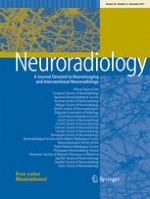Erschienen in:

01.12.2012 | Interventional Neuroradiology
Early and midterm results of complex cerebral aneurysms treated with Silk stent
verfasst von:
Murat Velioglu, Osman Kizilkilic, Hakan Selcuk, Burak Kocak, Ercan Tureci, Civan Islak, Naci Kocer
Erschienen in:
Neuroradiology
|
Ausgabe 12/2012
Einloggen, um Zugang zu erhalten
Abstract
Introduction
Endovascular treatment of intracranial aneurysms has been an effective treatment option. In this paper, we report our experience with the Silk stent (SS) for endovascular treatment of complex intracranial aneurysms and present periprocedural events, immediate results, delayed complications, and imaging and clinical follow-up results.
Methods
We retrospectively examined angiographic images and clinical reports of 76 consecutive patients with 87 intracranial aneurysms who were treated with SSs between March 2008 and June 2011.
Results
All aneurysms could be successfully covered technically using implanted SSs, with an overall mortality of 6.6 %. Two transient morbidities (2.6 %) and three permanent morbidities due to embolic events (3.9 %) were observed. Unexpected procedural technical events occurred in 18 procedures (18/78, 23.1 %). Control angiographies were performed in all 71 patients with 82 aneurysms (100 %). Mean angiographic follow-up time was 17.5 ± 11.1 months [range 2–48 months]. Sixteen of the 71 patients with 19 aneurysms had only early angiographic controls in the first 6 months while remaining 55 patients with 63 aneurysms (77.5 %) had late controls after 6 months. Overall control angiographic occlusion rates were as follows: 87.8 % (72/82) total occlusion, 8.5 % residual aneurysm filling, and 3.7 % residual neck filling. The general in-stent stenosis rate in controls was 5.6 % and the stented parent artery occlusion rate was 4.2 %. Five (6.6 %) aneurysms ruptured after stent implantation in our series.
Conclusion
The Silk stent is an effective tool for the treatment of challenging aneurysms, which have previously demonstrated higher re-growth rates and technical problems, despite unexpected higher hemorrhage rates after treatment and deployment difficulties.